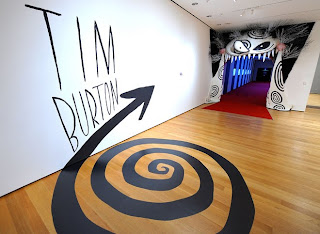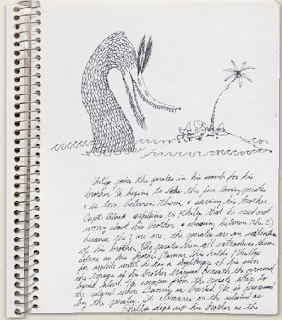Making Bad Art (Episode #3)
On the heels of my last post about Here Comes The Garbarge Barge and Red Nose Studio, I’d like to pick up this episode with something similar – claymation. While at the MoMA (Museum of Modern Art), I was able to see the current Tim Burton exhibition. As one might expect, it was completely fabulous.
I especially remember being surprised by both the size and intricacy of Burton’s claymation figurines. Though I I’ve always imagined them much smaller, in actuality they are about 12” tall. (I suppose that means the bizarre sets and landscapes Burton made for them to inhabit must too have been much larger and much more elaborate than I originally imagined.) Seeing the lifeless figurines extracted from their stories allowed me to appreciate them as crafted objects. All of the details, from the tiny lace on the corpse bride’s veil, to the nuanced expressions on Jack’s various heads, were simply stunning.
However not all of Burton’s works were so polished or impeccably executed. A few of his early animations were quite simplistic and most contained only fragments of his now distinctive style. There were also several sketches intermingled throughout the exhibit, that though comical, were sort of awful – full of scribbles, grotesque concepts or even (heaven forbid) clichés.
As a perfectionist, I found myself censoring certain images – deeming them too generic. I remember thinking ‘I would not display this or that if it were my show.’ Coincidentally though, one of the SCBWI (Society of Children’s Book Writers and Illustrators) sessions the following day squarely addressed my qualms.
In his seminar, Jim Benton said that as an author or artist one should be fully prepared and even expect to make bad art. He said that often the fear of producing bad, ugly or boring work sometimes squelches creativity. Adults, Benton continued, especially fall prey to fear because our rational minds betray us. It is all too easy to reason: “if I make bad art, then I must be a bad artist.” Which is a shame he pointed out since bad art has the ability to spark new or often better ideas. Benton went on to tell us about his Happy Bunny series (probably one of his most lucrative licensing projects). It began as a “smart ass” bad idea – a slightly belligerent joke pinned to his studio wall. But when stores like Spencer’s and Hot Topic became more popular, he was able to adapt it for that market. On the other hand, Benton was careful to explain that not all of his bad ideas resulted in such success. Many of them would never amount to anything and thus simply remain piled up in storage boxes.
I think I already knew that bad art could be helpful or even necessary. Being required to make and/or identify it in various classes had already opened my eyes to its potential virtues. Though I guess that knowledge hasn’t ever been enough to assuage my deep-rooted insecurity because I still have a hard time aimlessly doodling and sometimes I still tear drawings out of my sketchbook when ‘they don’t look right’ (I’ve found it a very nasty little habit to break). Benton’s reminder that it’s okay to experiment and make mistakes is one that I’ll probably have to hear over and over before it truly sinks in.
Fittingly, Benton concluded his session by having the audience create a story on the spot. And of course it was pretty bad – but that’s to be expected when there are 800 people contributing ideas all at the same time. It was a story of the impossible love between a platypus and a blender (or “blenda” as pronounced by the Long Island woman who suggested it as a character). Miraculously the tale ended when the blender gave birth to her half-kitchen-appliance-half-mammal-son. (He looked sort of like a food processor in Benton’s drawing). I doubt this story will ever become a bestseller and I don’t even think it inspired me to write a bestseller, but that’s beside Benton’s point. It isn’t always the end product that makes an activity worthwhile. In this case, it was the exercise itself – the act of freeing or stretching the imagination that was important.
(And the bad art that we produced? It was just bad art plain and simple. It didn’t mean that Jim Benton or anyone in the audience was a bad artist.)







Dana,
ReplyDeletethanks for the bad art topic and especially relating it to being neccesary in our creative process to spur us to do somehthing "better". It evokes the disbelief and shame that we did such a lame piece of work. Hopefully if you DON'T RIP IT OUT, you can see your solution, when you stumble upon it in your sketch book next time.. mary beth
I really liked this post
ReplyDelete